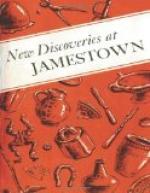[Illustration: The early Jamestown settlers were advised to equip themselves with “One Armour compleat, light.” (Conjectural sketch by Sidney E. King.)]
Farming
The first settlers brought seeds from England, and planted wheat 2 weeks after landing at Jamestown.
The early Virginians successfully grew many kinds of crops: grains (wheat, Indian corn, barley, oats, and rye), vegetables (peas, beans, turnips, parsley, onions, potatoes, cabbage, cauliflower, carrots, parsnips, lettuce, and others), and fruits (apples, peaches, apricots, quince, figs, grapes, and melons).
The colonists planted Indian corn as early as 1609, and cultivated many other Indian foods, including pumpkins, beans, and squash. They cultivated tobacco (an Indian plant) as early as 1612, and during the remainder of the century it was the most profitable crop grown. For many years it was the economic salvation of the struggling colony.
Attempts were made by the early colonists to grow other crops which, for various reasons, did not thrive at Jamestown. Some plants, like bananas, pineapple, citrus fruits, and pomegranates, could not withstand the cold Virginia winters. Other plants, including rice, cotton, indigo, sugarcane, flax, hemp, and olives, did not grow vigorously for one reason or another, and repeated efforts to cultivate them usually resulted in failure. Mulberry trees grew well at Jamestown (the leaves were used to feed silk worms), but attempts to make silk were not successful commercially.
[Illustration: Tools used in the cultivation of tobacco over 300 years ago. These tools—Hoe, billhook, and cutting knives—were excavated at Jamestown.]
[Illustration: Cultivating A small Garden in Virginia. (Conjectural sketch by Sidney E. King.)]
[Illustration: A few farm tools used by an early settler for cultivating his newly cleared land.]
[Illustration: Fishing provided food as well as recreation for the colonists. (Conjectural sketch by Sidney E. King.)]
[Illustration: A few of the many artifacts relating to fishing unearthed at Jamestown: FISHHOOKS, fish-gigs, and lead net weights.]
Handtools used by the Jamestown farmers during the 17th-century have been found in abundance. These include axes, picks, billhooks, pitchforks, spades, rakes, mattocks, sickles, scythes, broad hoes, narrow hoes, and shovels.




